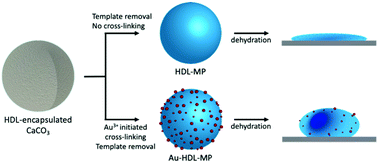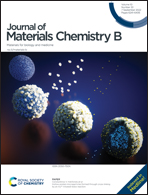Hollow protein microparticles formed through cross-linking by an Au3+ initiated redox reaction†
Abstract
Hollow microparticles (MPs) are of great relevance in the materials industry for a wide range of applications, such as catalysis, coatings, and delivery of theranostics. Here, we report the formation of hollow MPs through the assembly of lipoproteins in CaCO3 templates. Proteins interact in the pores of CaCO3 templates through attractive hydrophobic forces and form dense edges of hollow MPs. To further cross-link the proteins, Au3+ was added to initiate a redox reaction, where proteins were oxidized forming inter- and intramolecular covalent bonds, while Au3+ was reduced and gold nanoparticles (AuNPs) were formed. The obtained protein-based hollow MPs have a diameter of 6 μm and the AuNPs are embedded on their surface. Through this research, we suggest a new route to design biobased Au-protein hollow MPs in simple steps, which can allow new possibilities for carrying functional molecules and bioimaging.

- This article is part of the themed collection: 2022 Journal of Materials Chemistry B Most Popular Articles


 Please wait while we load your content...
Please wait while we load your content...